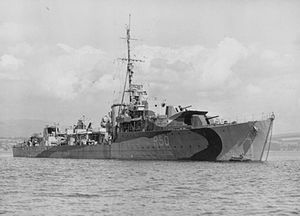|
HMS Venus (R50)
HMS Venus was a V-class destroyer of the Royal Navy that saw service during the Second World War. She was built by Fairfield Shipbuilding and Engineering Company, of Govan, Scotland and launched on 23 February 1943. Service historySecond World War serviceShe was part of the escorting destroyers of the 21st Aircraft Carrier Squadron involved in Operation Dracula from April to May 1945. She participated in the Battle of the Malacca Strait with the destroyers Saumarez, Verulam, Vigilant, and Virago which culminated in the sinking of the Japanese cruiser Haguro on 16 May 1945. Post war serviceBetween 1946 and 1949 Venus was part of the 3rd Destroyer Flotilla, based in the Mediterranean. This included work as part of the Royal Navy patrols preventing illegal Jewish immigration into Mandatory Palestine. In June 1946 she intercepted Josiah Wedgewood. On 2 August 1946 the British oil tanker Empire Cross exploded, burned and sank in Haifa Roads, Palestine, killing 25 people.[1] Virago and Venus took part in the rescue of survivors. Venus and Virago had been dropping depth charges in the area to deter Haganah frogmen from planting limpet mines.[2] Between 1949 and 1951 she was held in reserve at Devonport Dockyard. Between 1951 and 1952 she was converted at Devonport into a Type 15 fast anti-submarine frigate, with the new pennant number F50. Following conversion she became leader of the 6th Frigate Squadron. In 1953 she took part in the Fleet Review to celebrate the Coronation of Queen Elizabeth II.[3] In 1955 she was refitted for work as part of the Dartmouth Training Squadron.[4] Decommissioning and disposalIn 1964 Venus went to reserve and in October 1969 was in use as a target to measure the effects of ship to ship use of the Sea Dart missile system. She was sold to Thos. W. Ward for scrapping and arrived at their Briton Ferry yard on 20 December 1972 to be broken up. References
Publications
|
||||||||||||||||||||||||||||||||||||||||||||||||||||||||||||||||||||||
Portal di Ensiklopedia Dunia
